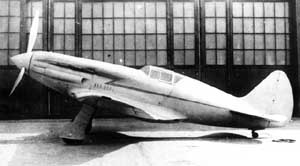Mikoyan-Gurevich MiG-1
|
|
| Mikoyan-Gurevich MiG-1 | ||
|---|---|---|

| ||
| Description | ||
| Role | Fighter | |
| Crew | one, pilot | |
| First Flight | April 5, 1940 | |
| Entered Service | 1940 | |
| Manufacturer | Mikoyan-Gurevich | |
| Dimensions | ||
| Length | 8.16 m | 26 ft 9 in |
| Wingspan | 10.20 m | 33 ft 5 in |
| Height | 2.62 m | 8 ft 7 in |
| Wing area | 17.5 m² | 188 ft² |
| Weights | ||
| Empty | 2,602 kg | 5,724 lb |
| Loaded | 3,099 kg | 6,818 lb |
| Maximum takeoff | 3,319 kg | 7,302 lb |
| Powerplant | ||
| Engine | Mikulin AM-35A | |
| Power | 1,007 kW | 1,350 hp |
| Performance | ||
| Maximum speed | 657 km/h | 410 mph |
| Range | 580 km | 362 miles |
| Service ceiling | 12,000 m | 39,360 ft |
| Rate of climb | 1,008 m/min | 3,306 ft/min |
| Wing loading | 177 kg/m² | 36 lb/ft² |
| Power/Mass | 0.32 kW/kg | 0.20 hp/lb |
| Avionics | ||
| Avionics | ||
| Armament | ||
| Guns | 1 x 12.7 mm BS machine gun 2 x 7.62 mm ShKAS machine guns | |
The Mikoyan-Gurevich MiG-1 (Микоян-Гуревич МиГ-1) was a Soviet fighter aircraft of World War II. Although difficult to handle, it formed the basis for the MiG-3, which proved to be a capable high-altitude interceptor aircraft and established a reputation for its designers.
The MiG-1 was designed in response to a requirement for such an interceptor perceived by the Soviet Air Force in January 1939. Initially, Artem Mikoyan and Mikhail Gurevich were competing against Nikolai Polikarpov to fill this niche, but when Polikarpov fell out of favour with Stalin, Mikoyan and Gurevich's design was suddenly accepted for development in November, with a deadline of April for the first flight. As specified, the aircraft was to use the Mikulin AM-37 engine and was to be capable of reaching 670 km/h (417 mph). The approach that Mikoyan and Gurevich selected was to build the smallest possible aircraft around the intended powerplant, thereby minimising weight and drag - the philosophy of the light fighter.
The result was a highly conventional aircraft that flew on schedule on April 5 1940, although its intended powerplant was not ready in time. Instead, the new fighter flew with the less powerful AM-35, and even with this soon broke the Soviet air speed record by 40 km/h (25 mph). It could not, however, attain the speed originally specified by the air force with this engine. Initially designated I-200, the MiG-1 was put into production almost immediately, and by the end of the year, the type was already being delivered to test squadrons. Here, it was discovered that the high wing loading of the small aircraft produced some very nasty handling problems, including tendencies towards both stalling and spinning, and a lack of directional stability.
As reports of the handling problems came back to Mikoyan and Gurevich, they worked to remedy them, eventually incorporating so many design changes that the type earned the new MiG-3 designation.
| Related content | |
|---|---|
| Related Development | |
| Similar Aircraft | |
| Designation Series | |
| Related Lists | List of military aircraft of the Soviet Union and the CIS - List of fighter aircraft |
|
Lists of Aircraft | Aircraft manufacturers | Aircraft engines | Aircraft engine manufacturers Airports | Airlines | Air forces | Aircraft weapons | Missiles | Timeline of aviation |
